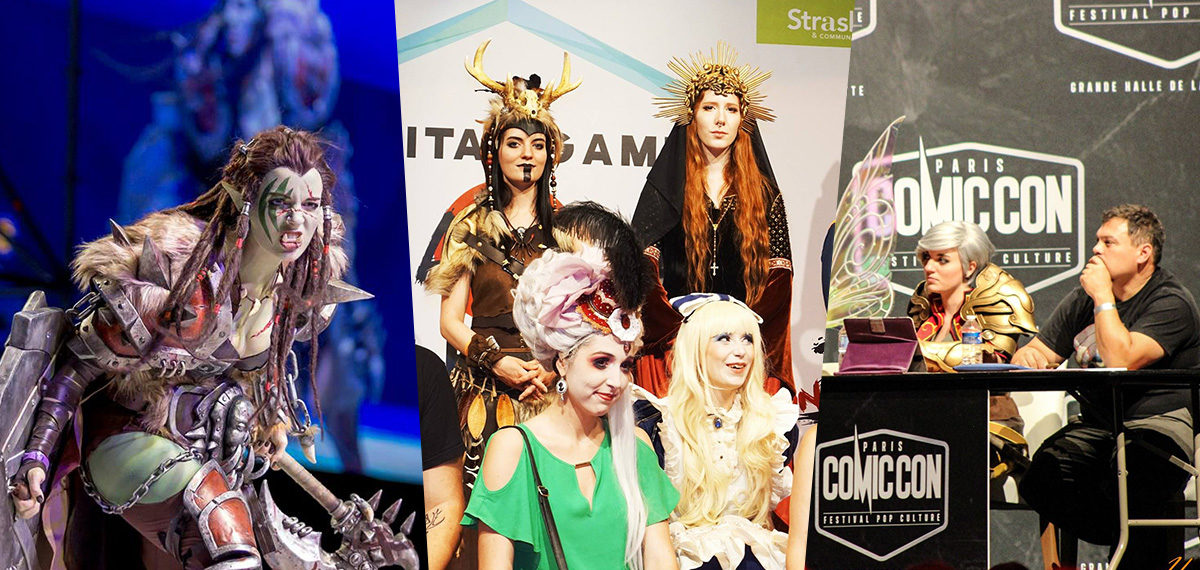
Behind the scenes of cosplay contests
When I recently noticed that I have been a cosplay judge 11 times in less than 2 years, I thought it could be interesting to share my experiences with you. 🙂
Many thanks to all the people who asked their questions so that I could elaborate this post. If you have more, please ask them in the comments.
The cosplay contest
It’s first and foremost a place to have fun. You can meet and connect with the other cosplayers, the staff and the judges. Backstages and changing rooms are great places to bond with new people who share the same interests.
Do not expect to enjoy the convention activities when you are into a contest. From the meeting point, the prejudging, the stage performance and all the way to the awards ceremony, you’ll spend most of your time backstage. And don’t forget photoshoots, and the the fact that crowded alleys might damage your costume (uh, the fear of breaking a piece before you go on stage…)
Different kind of contests
In Europe, we are more used to contests with a stage performance. Cosplayers prepare a soundtrack with a short skit that they will play in front of the audience and the judges. It’s a short scenery with dialogues, fight, vocals, dance, funny skits… it’s up to the cosplayer to choose his way to showcase his costume.
In the US, you will mainly have maquerades and no (big) planned performance. I know that many french cosplayers are unseasy with this concept, but I can assure you that it’s not simpler nor more difficult, it’s just a different practice. The point is : the cosplayer walks on stage, takes some poses at set points on stage (tape on the floor, staff indications, platforms, etc.) while a host announces his name, the character he’s playing as, the origin of said character, sometimes tells interesting facts about the costume, then the cosplayer leaves the stage. It requires less preparation than a skit, but you’ll need to be careful about other things. You’ll have to focus on roleplay without audio support, do improv, try to be in synch with the ambient music. You generally have to walk across the stage, so you’ll need some mobility on your costume. Nothing is more stressful than being stuck or slowed down by a tight dress or stiff armor parts. This kind of contest has a steady pace : each contestant must be ready to enter on stage as soon as the previous one is gone. Attendees have less time on stage, but on the other hand it’s easier to fit 40 cosplayers in the same timeframe…
Contest steps
- Meeting point : The cosplayers are often asked to come in earlier on the day of the contest to confirm their registration before a set time. Sometimes, you have to be dressed up in costume already. But it depends on the schedule of the contest and prejudging. Look it up beforehand ! 😉
- Usually, once you are at the meeting point, someone will explain you how the contest will unfold (if not already be done by email, on the website or in the contest rules). You’ll have a new appointment time for the prejudging (there are prejudgings in most contests nowadays).
- Prejudging : Each cosplayer goes individually (or as a group for group contests) in front of the panel of judges. You usually have between one and five minutes to show off your costume and try to score as many points as you can. 😉
- The time between prejudging and on-stage performance varies widely from contest to contest, sometimes you’ll have to wait 10 minutes (if you are among the last ones to go in front of the judges, and if the contest is scheduled right after), and sometimes up to 6 hours… Some contests, in the US for example, have so many attendees that it’s possible to meet the judges at 1pm, and to go on stage at 7pm (when it’s on time ! ^^)
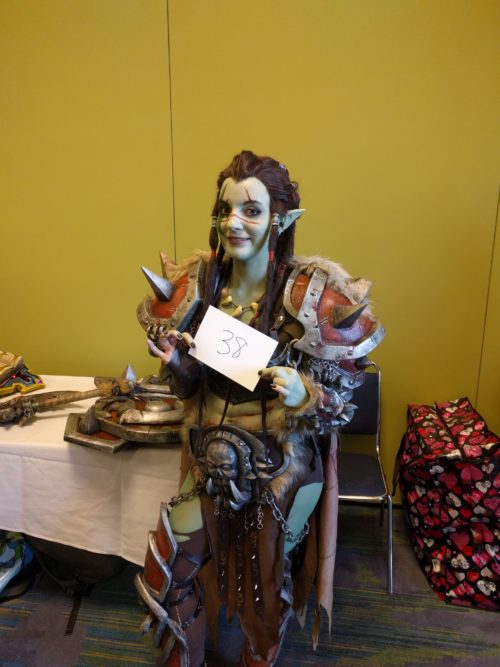
- Stage performance : Your time to shine as a cosplayer. A performance, a costume showcase, some lights and an epic soundtrack. Usually, you’ll find the judges sitting in front of the scene at a table, sometimes it’s even on the side of the stage (like at Comic Con Paris), or at the back of the stage, behind the cosplayer (like at C2E2).
- Deliberations : Duration of the deliberations may vary widely (between five minutes and a few hours), judges withdraw to discuss and choose which cosplayers should be awarded.
- Winners announcement : It can take place hours after the cosplay contest, sometimes at the end of the day, on the stage’s last time slot. The host and the judges announce the different prizes and the winners of the contest.
Rating
Each convention, each cosplay contest organizer and perhaps even each cosplay judge, will have his own scoring grid.
On a costume, many things are taken into account : the overall quality, the amount of work it took, the diversity of techniques used, the choice of materials, the details, the finishing touches, how pieces articulate together, the overall mobility relative to size, the accuracy of the colours, the fidelity to the reference picture, the originality in the craftsmanship or the choice of the costume…
On a stage peformance : the role play, the originality of the skit, the understandability of the scene, the quality of the soundtrack…
In some conventions, costume and performance are judged as equal parts. In others, it’s more focused on the costume. A small example : in the ECG selections (Japan Expo), there is a 50% – 50% rate between costume and performance, and a rate of 90% for the costume and 10% for the performance in the French Championships of Cosplay (Comic Con Paris) !
Ranks are often 1st, 2nd and 3rd (with usually a solo and a group rating), but depending on the contests you can find “special prizes” or categories.
A few examples (you will discover that there are almost as many ranks as there are contests) :
- At Comic Con Paris, prizes were 1st place sewing category, 1st place armor category, 1st place FX category, and the Great Winner was selected among these three prizes.
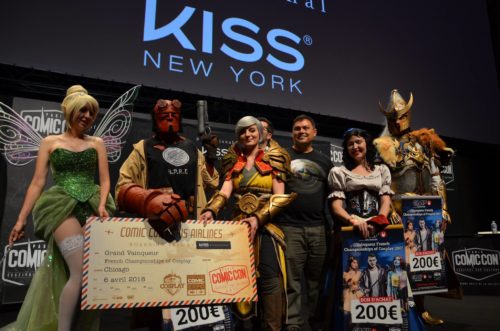
- When we participated in the Fantasy Basel cosplay contest, there was a similar category system, but a bit wider : 2nd places with categories : armor, sewing, performance, etc., a 1st place Cosplay of the Day, and a 1st place Festival Winner (chosen between the three “Cosplay of the Day” winners).
- At the ECG french selection, there is a solo winner, a solo runner-up, a group winner and a group runner-up.
- At Senyu, there were some “Espoir” prizes to award young talents in some categories : performance, costume…
- At Cosplay’in Wesserling, Geek Unchained or Necronomi’con, you also had an “Audience’s favorite” price (you can vote on a paper or directly at the contest booth).
Contests rules
- Handmade : each contest has its own policy about handmade. International and national contests usually ask for a costume at least 80% handmade. It is usually written in the contest rules, sometimes you only have this mention “The costume must be handmade”… But this doesn’t mean that you need to have a 100% handmade costume. Obviously we buy shoes most of the time, the same goes for tights. You can make a petticoat on your own, or you can buy one. The trick is to be honest and to tell the judges which parts were bought or handmade. Customization (shoe cover, refined clothes, dyeing, adding beads, fabrics, prop kits, etc.) will count or not for a handmade piece according to the degree of modifications you have made to them.
- Skit or no skit ? That is the question ! Rules may vary from a contest to another, but it’s usually mentioned in the rules or the registration form. When it’s not demanded or optional, maybe you can have an ambient music to walk on stage. When you HAVE TO make a performance, you will have to provide a soundtrack (or a video, see below).
- Duration of the performance : Nowadays, in most contests, You’ll have a time limit for your skit. 1, 2, 3 minutes… Group skits are normally a bit longer than solo skits (1min30 for solos, 3min for groups for example).
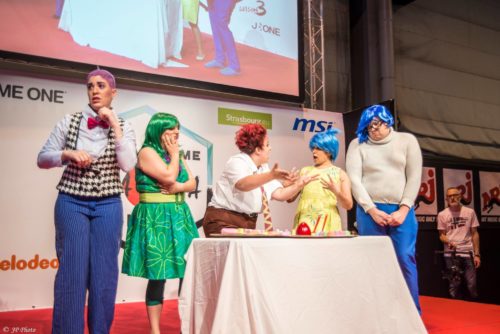
Costumes (from left to right) : Fear / Fenouil Cosplay, Disgust / Saru Cosplay, Anger / Eiryhan Créations, Joy / Firefly Cosplay et Sadness / Yoshii Cosplay (Vice Versa) – photo : JP Photo.
- Soundtrack / video : When you register for a cosplay contest, you will be informed about the way to provide your soundtrack (online form, email, on a USB key…). Some contests offer the possibility of sending a video, but be careful, it’s not always the case, so think about checking the rules or ask !
Small tips : Test your file on several players (VLC, Windows Media Player, iTunes, etc.) and use standard formats if possible (mp3 or wav for the audio, mp4, avi, mov… for video). - Props and weapons : Check the rules about weapons, replicas and props before you register in a contest (allowed materials, realistic replicas, uniforms, airsoft, etc.) Sometimes rules are the same for the contest and the convention, but you can also have special rules (more flexible) for contestants. You may have to go through a special queue when entering the con, or another access, may need to print a receipt or something else.
- Reference picture : In many contests, you will be asked to provide a reference picture, sometimes it’s required, sometimes optional. Usually it serves as a reference for judges, so that they can compare to the costume, sometimes it’s displayed on a screen when you go on stage. The reference picture has to be as close to the costume as possible, don’t take one with pieces that you didn’t make just because it’s prettier. Prefer full body pictures, and avoid portraits (that’s not really convenient to rate a costume when you only have a face as a reference). If possible, avoid fan arts (except if your costume is made from a fan art).
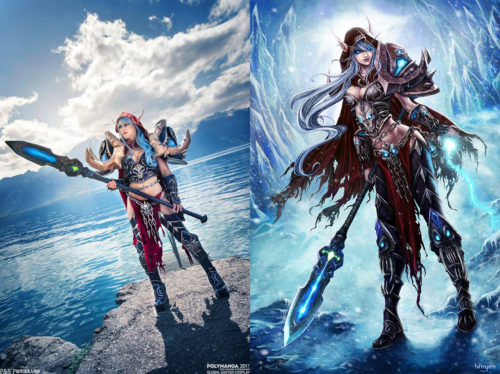
- Original creations, fan arts, genderbends, crossplays, gijinkas, steampunk, etc.
Some contests do not allow fan arts or original creations (even if you made the drawing by yourself), the same goes for genderbends (female version of a male character, male version of a female character), but also for gijinkas (humanized version of a non-human character, often applied on pokemons, but also on robots or animals…) and steampunk (original creation or steampunk declined character). Usually there is no problem with crossplay (a girl who interprets a male character, a boy who interprets a female character), as there is normally no modification of the costume from its reference. If you have a doubt, ask the contest organizers.
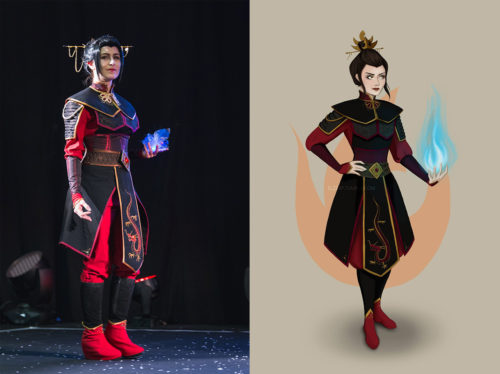
- Stage props : Usually, you can bring stage props with you. There can be a limit for the number of props you can bring, their size or their weight… some conventions don’t have dedicated staff for this, and maybe you’ll have to install your props on stage by yourself. If it’s written in the contest rules that’s fine, if not just ask.
Of course, contests rules may vary a lot from one convention to another. “Local” conventions are often more flexible than national selections. If you want to attend a cosplay contest for the first time, small and medium conventions are usually less intimidating and strict in their rules. The atmosphere is also more friendly and less competitive (it doesn’t mean that bigger contests atmosphere is not friendly :P)
Judges
Quite often, the judge panel is composed of cosplayers, but it’s not always the case ! You can also find costume designers, professionals from theaters or from the film industry, make up or FX artists, photographers, studio directors…
A few tips for cosplayers who attend contests (or want to) :
- Have fun ! If you enter a contest only to win, first you might get disappointed if you don’t get a prize, and you may miss on having a great time with the other cosplayers. It’s good to be motivated by competition, but don’t get blinded by it, have fun above all.
- Get to the convention earlier than the indicated time : waiting lines, finding your way in the convention, locating the meeting point… all of these can take some time and will become really stressful if you are on a tight schedule!
My sister will always remember the Fantasy Basel cosplay contest where she accompanied us : we had to get dressed in the parking lot because there was no real changing rooms in the convention. There were three buildings with three different entrances, waiting lines with or without pre-sale tickets, several floors, some with elevators, the last one accessible by an escalator on the opposite side of the hall, german or english-speaking staff, visitors taking pictures…It was a bit hard for us to find the prejudging spot in time. So yes, follow this advice, be there in advance 😉
Registration
- Get to know everything before you register : schedule, notation grid (rating percentages for the costume / skit), changing rooms (and opening hours), rules regarding weapons replicas, if you need to be dressed up for the first meeting, maximum duration for the skits, if you are allowed to bring stage props, soundtrack or video, how many persons are allowed if you compete as a group, judges nationalities (or at least which language they speak)… Every little information can be useful, and if you have any doubts, do not hesitate to ask questions.
- Choose your reference picture(s) wisely. Avoid unnecessary elements : if it’s possible, avoid pictures where you have additional elements or props that are not made on your costume (sword, helmet, collar, hat…), it can give the feeling that the costume is not finished.
- If there are several categories in which you can register, be sure to choose the right one. When the choices are solo or group it’s easy, but sometimes you have precise categories like : sewing, armor, make up, wig styling, etc. think about it first. Try to imagine which kind of cosplays could be contesting in these categories, and choose accordingly.
Pre-judging
- Be on time (and dressed up)! Prejudging time is limited, judges need to see every cosplayer before they go on stage, so try to be there when it’s your turn. If you’re not, you could be penalized or even eliminated!
- You arrive in front of the judges, if you’re a bit nervous and you don’t know how to start, start with a simple and audible “hello”, usually that’s enough to start the conversation. If you’re a bit lost, don’t mind telling the judges, ask them what they want to know, and encourage them to ask questions.
- You could also avoid being lost by preparing in advance what you want to show to the judges.
- Do a list of the materials and techniques that you used on your costume.
- Prepare the answers to the questions that could be asked like : How much time did you spend on the costume? Which part was the hardest to craft? The one you prefer? The one you are the proudest? Which difficulties you encountered?
- Don’t forget to mention every part of your costume that you bought or required external help. You won’t necessary be penalized if your grandmother helped you to sew a hem or if you bought your shoes… In any case, it’s better to be honest and rewarded for your own work than another’s.
- Try to order your points in your head, you can for example start from the top (wig, helmet…) and go down progressively to the bottom (shoes).
- Feel free to mention every notable point : it’s your first costume / contest / skit / armor / dress… if it’s made with recycled stuff, etc. All that is out of the ordinary. Show them you are unique !
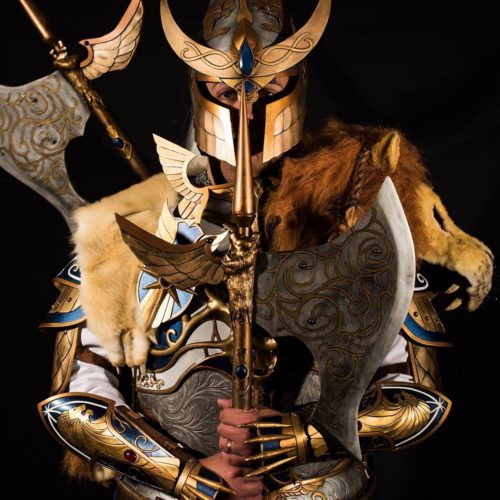
Costume : White Lion of Chrace (Warhammer) by Aldarion Cosplay – photo : Studio Galy – Garnier Charly.
- Focus on the best parts of your costume, and go faster over the ones you like the least. Don’t bring yourself down!
- If you had to send a reference picture at your registration, it should normally have been provided to the judges in a folder, book or something like that. But you can bring it with you just in case. And if no reference pictures were asked, bring them with you anyway, it will give the judges an idea of what it should look like, they will be thankful for that.
- WIP (Work In Progress pictures) : You can have WIPs of your costume with you. It’s still quite uncommon to see some right now, but it can bring you some additional points if it’s correctly done. Be concise, prefer images over long texts, maybe write some interesting facts (time spent on your costume, materials listing…). Keep in mind that it’s your job to explain your costume, WIPs only serves as a support to your explanations. This can take several forms : on your phone / tablet PC (but beware not to waste time searching for your pictures), on paper (quicker, but pay attention to the printing quality, you do not need to buy it from a professional printer, just ensure it is readable).
- Smile and be positive.
- After the Comic Con Paris cosplay contest, I’ve had some feedbacks from the contestants, who were a bit frustrated or disappointed because the translator didn’t translate all that they said to the english-speaking judges. Don’t panic. After having seen a few contestants, judges will understand what you are talking about without any translation, and if there is any doubt or misunderstanding, they’ll just ask 😉
- This brings me back to the english language… In many contests you just have a very limited time with the judges, if you’re not comfortable with english, don’t hesitate to be helped or translated ! It’s really brave if you want to explain by yourself with your own words, but it could penalize you if you take too much time. And confusing the judges with gibberish might not work well, especially if you’re talking about complex crafting situations.
- Once the prejudging is finished, you will always think about the things you forgot to mention… Note this for the next time and set it aside to enjoy the rest of your day.
Costume
- When deliberations are tough, the details often make the difference.
- Leave no room for little mistakes : be mindful of visible staples on your props, too “flat” painting, Worbla that was not sanded enough, unclean hems, dresses that are not well ironed, orange thread that should be white according to the reference picture… everything matters!
- Consider the universe whose your character comes from, don’t hesitate adding details if it’s justified by his environment and serves the costume : blood splatters on an axe, damaged and weathered fabrics for a barbarian, post-apocalyptic rust, dry leaves in a wilding’s wig, adding an underskirt to hide a petticoat… sometimes some elements are supposed to float in the air, which is not possible. Feel free to place decorative clasps or buttons according to the character design. Add what you want, within reason (don’t change too much things from the original reference), but, above all, please state every modification during prejudging.
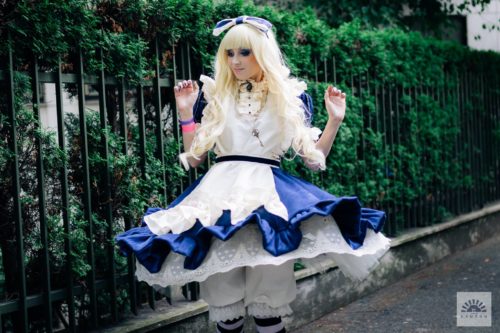
- This could seem obvious but… try your costume before the contest. Be sure you can move properly. Even better, rehearse your performance while wearing your costume.
- If possible, iron the cloth parts of your costume. Try to pack them, leaving as few folds as you can. My tip is to roll fabric parts to avoid the big cross folding mark…
Performance
- We often say to focus on the originality (that’s right, don’t do as everyone does), but you should also be careful about the comprehension of your skit.
1st example : a japanese skit with no captions. Anyone who knows the anime/manga may not be bothered, but there is a chance that a newbie would get bored.
2nd example : Private jokes – if you do an humorous skit, try to make it understandable for the largest part of the audience and not just the ones who saw the movie, or played the game it comes from. Except if it’s a reaaaaaaally well known license (#iamyourfather). - Watch other contests, search for inspirations, but do not copy !
- If you enter contests several times with the same costume, try to make something new. Don’t play the same skit three times in front of the same audience every three weeks…
- If the judge panel is english-speaking, you can dub the skit in english, but make sure the audience will understand too. If possible, add subtitles on a video, it’s even better.
- Beware of subtitles (lol)… People tend to read instead of looking at you, so if you’re using captions, be careful to make them short.
- If there are dialogues or singing in your skit, train yourself to dub over it. You can listen to it on repeat so that you get used to the rhythm and know it by heart.
- Pay attention to the quality of your soundtrack :
- If you use parts of soundtracks (movie, cartoon, videogame…), be careful on the transitions and avoid the “chopped” effect.
- If you record a voice, take great care in your recording quality. You may write a great story but it will be useless if no one understands it.
- Be soft with voice modificators : you may want to change your voice (to make it deeper for instance) but don’t overdo it so it remains understandable. Depending on applied effects, it is sometimes advised to speak more slowly. Make some research and watch some tutorials before 😉
- Equalize the sound of your soundtrack : try to have a balanced volume between voices, music, explosions…
- “Performance duration is limited to 2 minutes for solo, and 4 minutes for groups, can I make it shorter ?”
The answer is YES. Do not force yourself to hold the whole time specified in the rules if it’s just for filler. Better keep it shorter and effective than long and tedious.
After the contest
- Ask the judges for feedback. In most cases, judges will be happy to talk, encourage and advise you.
- Whether you win or not, be proud of yourself.
- Take notes for next time, and exchange contact informations with other contestants so you can keep in touch 🙂
Random questions
How is 3D printing perceived ?
Even if at first it was a bit bad perceived by some cosplayers, it’s an actual tool that is more and more common and that you can use on your costumes, even in a contest. However, remember to inform the judges if you made the 3D model on your own, if you made some changes on a model you found, or if it was ready to print. The amount of work may vary from a piece to another and depending on the printer you’re using, feel free to provide details about your work (cuts, if you needed to print the piece in several parts, sanding, painting, etc.)
Tips for judges !
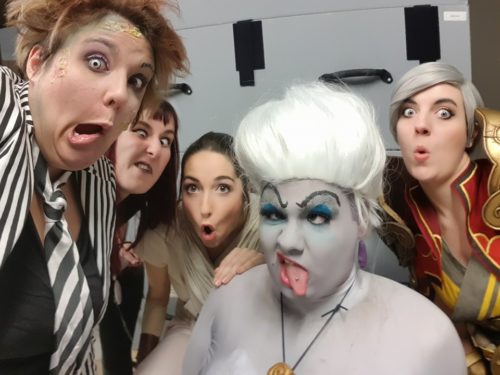
From left to right : Beetlejuice / Eiryhan Créations, Aishi World (organizer of the cosplay contest), Rey / Melyanis Cosplay, Ursula / Yoshii Cosplay, Monk / Black Owl Studio – photo : Eiryhan Créations
Well yes… you often find advice for cosplay attendees, but more rarely for judges ! It is therefore an exercise that can be difficult if you have never done it before.
- Welcome the contestant, if he’s comfortable the interview will be more fluid. Ask some simple questions first : which character is he cosplaying as ? Which materials were used ?…
- Try to maintain homogeneity between contestants, ask them similar questions each time.
- Look at every piece of the costume, don’t forget the back, armor pieces hidden by a cloak, petticoats, etc.
- Follow the rating grid : if the organization staff gives you a grid with criterias, target questions according to these. Each contest has its own grid :
- with noted criterias, a certain amount of points for each one, and a global sum,
- with criterias and free rating (score out of 10, 5, with + and -, as you want),
- with criterias but no rating (take some notes),
- free grid (blank space, no criteria) – In these cases, I usually make my own grid (for example : costume quality, techniques & materials, skit originality, comprehension… + bonus points if there are some particular elements).
- Don’t follow the rating grid 😀 : use it as a guide, a reminder. Your way of rating will change as you will see more and more contestants, it is therefore a bit tricky to do an objective ranking as it evolves. You can re-balance the first contestants scores (now that you have a benchmark), but trust your feelings, it’s impossible to map all criterias in a grid, look at the ones mentioned and add yours. When deliberating, it’s rare that the final ranking is simply made by the sum of points in the grids, it’s more like a debate between the judges in order to find a result that suits everyone (or at least the majority).
- Don’t forget to ask which prizes are awarded before prejudging. If you have a sewing prize, an armor prize, a performance prize, etc. maybe you will ask different questions than if it was 1st, 2nd, 3rd… Likewise, it can happen that there are “favorites” prizes for those who are out of the box, or “espoir” prizes to encourage young talents… Keep the ranking and categories in mind when you see each cosplayer, and even more when you deliberate.
Notes for spectators
- It’s often easy to make your own mind and your own ranking when watching a cosplay contest. Sometimes results don’t match what you thought. Before you stir up scandal and accuse judges of corruption (everyone knows we can be bribed with cookies), keep in mind that judges spent several hours looking at each costume during prejudging. Sometimes, a discreet costume will have more details and be more complete than a bigger one that will look great from where you are seated. If you liked a costume and are disappointed about the results, go and have a nice word to the cosplayer you liked most, follow his page and show him support (without bashing the others, who also worked hard), this will be a nice reward too.
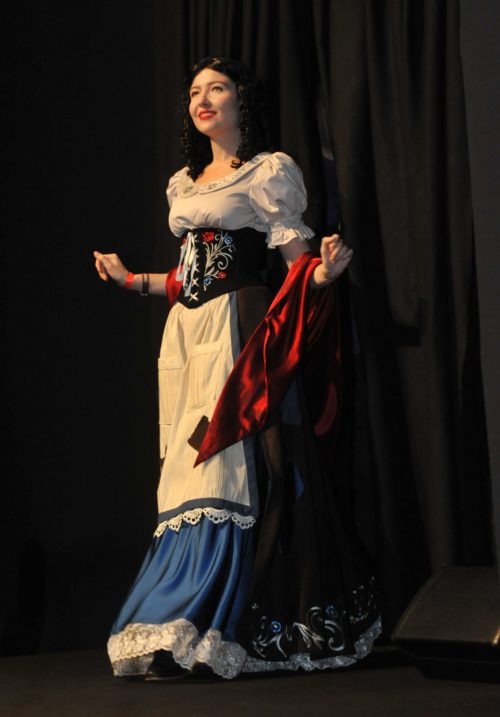
- As I said before in the contest steps. Winners announcement often takes place hours after the contest. It happens that awarded cosplayers are no longer in costumes. Don’t blame them, and try to put yourself in their shoes, that’s not easy to wear a cosplay and sometimes it’s better to take it off instead of fainting 🙂
I hope this post will help you. If you have other questions, or want to share your own experiences, please leave a comment !
Comments (0)